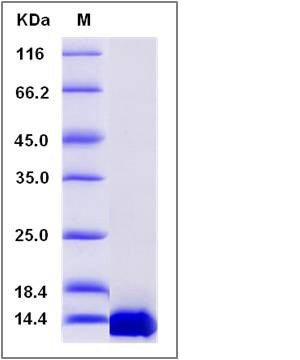Human TFAP2C / AP2-GAMMA Protein (His Tag)
AP2-GAMMA,ERF1,hAP-2g,TFAP2G
- 100ug (NPP2536) Please inquiry
| Catalog Number | P13115-H07E |
|---|---|
| Organism Species | Human |
| Host | E. coli |
| Synonyms | AP2-GAMMA,ERF1,hAP-2g,TFAP2G |
| Molecular Weight | The recombinant human TFAP2C consists of 111 amino acids and predicts a molecular mass of 12.3 KDa. It migrates as an approximately 12-14 KDa band in SDS-PAGE under reducing conditions. |
| predicted N | His |
| SDS-PAGE |  |
| Purity | > 98 % as determined by SDS-PAGE |
| Protein Construction | A DNA sequence encoding the mature form of human TFAP2C (Q92754) (Leu128-Val223) was expressed with a polyhistide tag at the N-terminus. |
| Bio-activity | |
| Research Area | Signaling |Signal Transduction |Transcription Factors and Regulators |Other Transcription Factors |
| Formulation | Lyophilized from sterile PBS, pH 7.4 1. Normally 5 % - 8 % trehalose, mannitol and 0.01% Tween80 are added as protectants before lyophilization. Specific concentrations are included in the hardcopy of COA. |
| Background | TFAP2C, also known as AP2-GAMMA, is a member of the activating protein 2 family of transcription factors. AP-2 factors bind to the consensus sequence 5'-GCCNNNGGC-3' and activate genes involved in a large spectrum of important biological functions including proper eye, face, body wall, limb and neural tube development. They also suppress a number of genes including MCAM/MUC18, C/EBP alpha and MYC. TFAP2C may be prognostic indicators for patients with breast tumors. TFAP2C gene has been tested for association to diseases (Breast Neoplasms; Carcinoma) and proposed to participate in processes (cell-cell signaling, male gonad development, regulation of transcription from RNA polymerase II promoter). Proteins are expected to have molecular functions (DNA binding, protein binding, protein dimerization activity, transcription factor activity) and to localize in various compartments (membrane, nucleus). |
| Reference |
